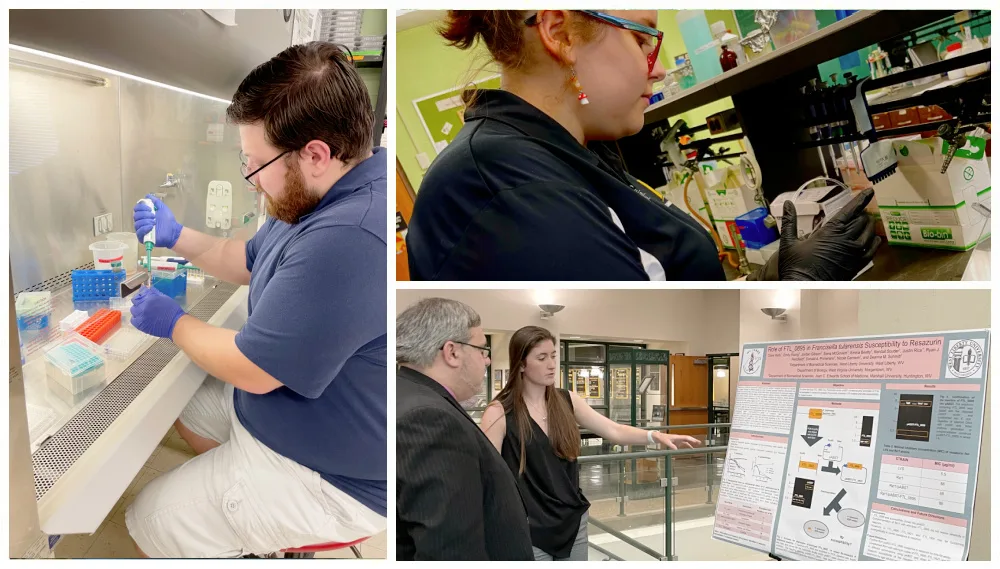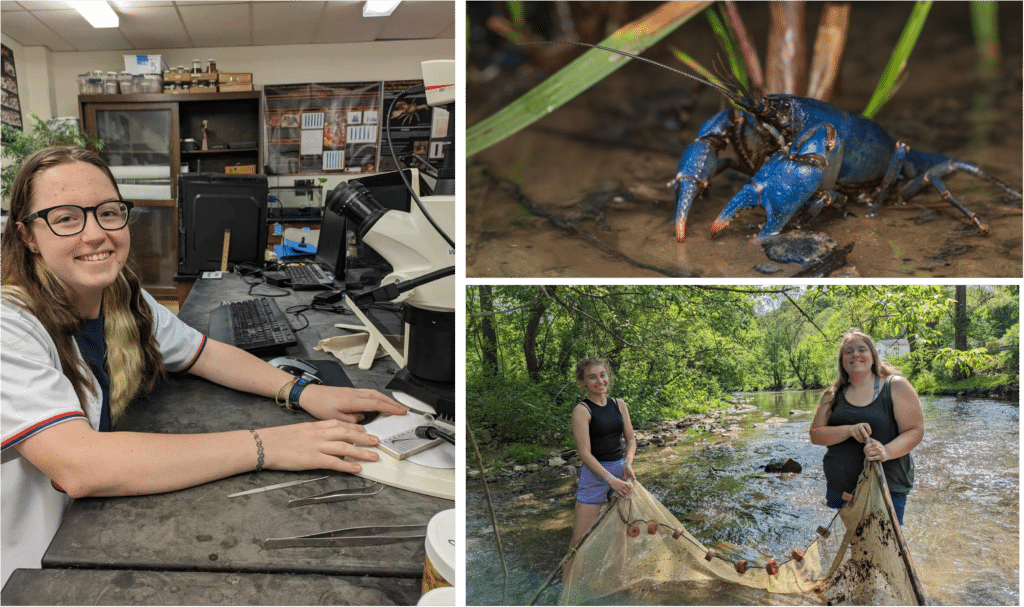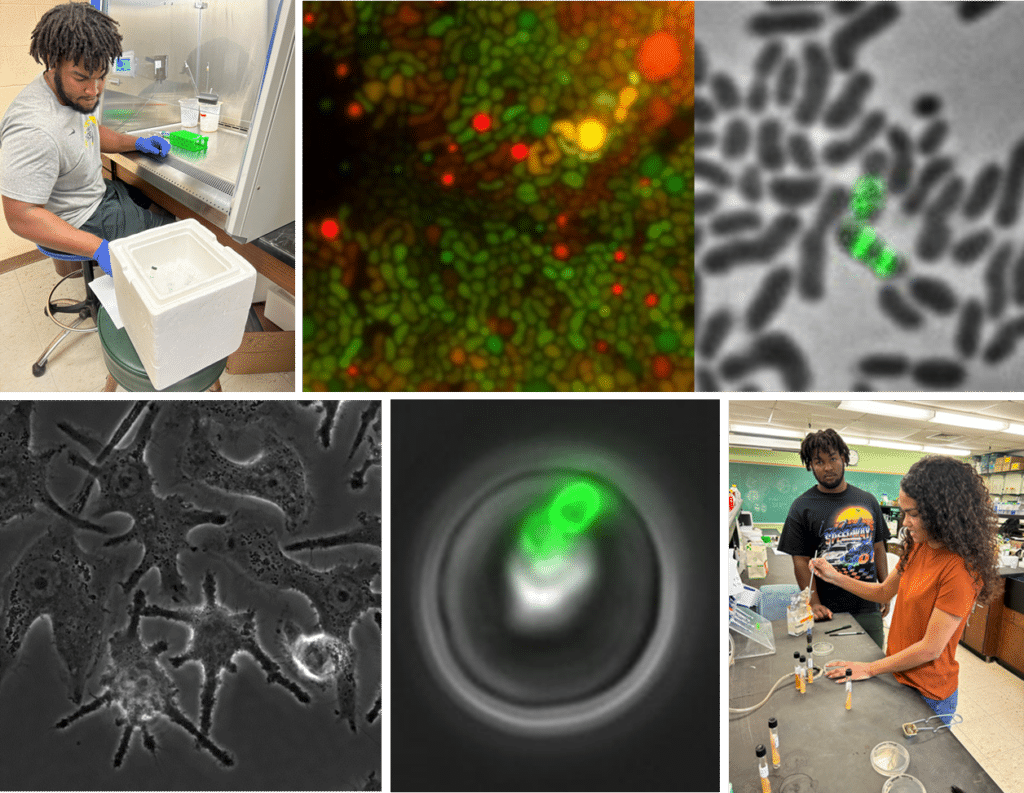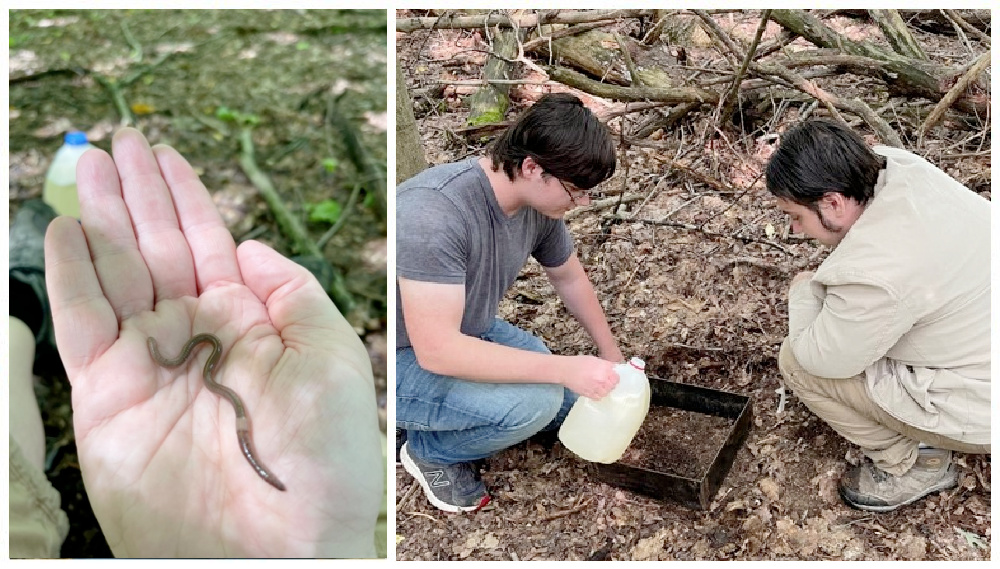Sound like fun? Apply today!
- APPLY – Send a cover letter containing:
- Preferred research project(s)
- CV
- Contact information for three references
- Unofficial transcripts to TOPPER-SURE@westliberty.edu
- QUESTIONS – Send your question to TOPPER-SURE@westliberty.edu
Areas of Research | Making Connections | Apply Today
Projects under the guidance of Dr. D. Schmitt
Mechanisms of Novel Antibiotics
– Dr. Deanna Schmitt
Antibiotic resistance is a global health threat that is limiting treatment options for many infectious diseases. Each year, there are significant increases in the number of deaths due to antibiotic-resistant infections and health care expenses associated with these diagnoses. This information illustrates the need for new drugs that can combat the ever-increasing prevalence of multidrug-resistant pathogenic bacteria.

The Schmitt laboratory studies resazomycins, a novel family of antibiotics that exhibits bactericidal activity against select Gram-negative bacteria, including Francisella tularensis and Neisseria gonorrhoeae. The primary goals of Dr. Schmitt’s research are: 1) determine the mechanism of action of resazurin and 2) improve its therapeutic efficacy in vivo. TOPPER-STURE students would be involved in conducting various microbiological and biochemical assays to determine the role of various F. tularensis genes in resazomycin susceptibility. Additionally, Dr. Schmitt has formed a collaboration with an organic chemist at West Virginia University to synthesize a library of chemically distinct resazurin analogs that TOPPER-SURE students will test for enhanced antibacterial activity in the presence of serum albumin and under low oxygen conditions.
Projects under the guidance of Dr. H. Vopal
Thyroid-Related Mechanisms in Craniosynostosis – Dr. Holly (Racine) Vopal
Craniosynostosis is the premature fusion of one of more cranial sutures. Craniosynostosis occurs in every 1 in 2100-2500 births. 90% of these causes are considered non-syndromic (NCS), meaning not caused by genetic mutations and not associated with dysmorphisms of the face, trunk, or extremities.

Complications with craniosynostosis include increased intracranial pressure which may cause developmental delays, sensory dysfunctions, respiratory dysfunction, and neurological dysfunction. Maternal hyperthyroidism is a factor contributing to the development of NCS, but the mechanism for circulating thyroid hormone (TH) augmenting cranial suture closure is not well understood.
The Racine laboratory studies the effects of increased circulating TH on development in an avian model. TOPPER-SURE students would be involved in conducting live animal experiments using a novel model for maternal hyperthyroidism in chicken embryos. This model will aid in the understanding of the molecular mechanisms by which increased TH stimulates cranial bone development in utero.
Projects under the guidance of Dr. Z. Graham
Crayfish Biodiversity
– Dr. Zackary Graham
Dr. Graham’s research takes an integrative approach to understand how and why animals (especially freshwater crayfishes) are so diverse. His work combines morphological, behavioral, and comparative data to explore the causes and consequences of biodiversity across the 700+ species of crayfish.

WLU is perfectly positioned for this research, as the Appalachian Mountains are a hotspot for crayfish diversity, with over 30 native species in West Virginia alone. The majority of Dr. Graham’s research is conducted on local species that are amenable to such studies (i.e., Cambarus carinirostris, Cambarus robustus, Faxonius obscurus). However, Dr. Graham also regularly conducts collections-based research with the WLU Astacology Collection, as well as other invertebrate zoology collections across the eastern United States.
In addition to working with museum collections and studying crayfish biodiversity, Dr. Graham is also involved with the conservation and management of various local crayfish species. Thus, students working with Dr. Graham are likely to experience a combination of field and lab work during summer research experiences.
Projects under the guidance of Dr. D. Barber
Bat Biodiversity/Snake Personality
– Dr. Diana Barber
North America’s insectivorous bat communities provide essential ecosystem services whose agricultural value is estimated to be in excess of 22 billion dollars per year and yet several species are at risk of extinction from land-use activities (principally forest clearing) and white-nose syndrome (an invasive fungal infection that impacts hibernating bats). The bats of the northern panhandle in West Virginia have not been comprehensively surveyed in decades.

The Barber lab will help address significant gaps in our understanding of our local bat communities in part by evaluating the impact of anthropogenic disturbance on insectivorous bat communities. Chiropteran communities have been understudied in the northern panhandle of West Virginia, but are potentially at increased risk due to increases in energy production in the region. The impact of anthropogenic disturbance will be evaluated by comparing species richness along a continuum of disturbances. Species richness will be determined through passive recording of echolocation calls and walking transects with a recorder. Species will be identified with the assistance of acoustic analysis software (Kaleidoscope Pro). Chiropteran communities differ in their susceptibility to anthropogenic disturbance and differences in foraging behavior may predict how species is impacted by disturbance. Data collected as part of this project will also contribute to a long-term acoustic transect study being done by the West Virginia Department of Natural Resources to track the population and distribution of bats in West Virginia.
Snake Personality:
Dr. Barber’s lab will also be investigating the impact of natural history and experience on personality by measuring boldness and exploratory behavior in Western Hognose Snakes (Heterodon nasicus) in 2024. The Western Hognose is an excellent model organism due to their popularity in human care and wide behavioral repertoire. Snakes will be evaluated for the impact of different life experiences by exposing the experimental group to novel, non-threatening environmental experiences. The control group will be removed from their home enclosure and placed in a safe, non-stimulating space for the same amount of time. Both groups will be tested in an arena they have never experienced before, and latency to explore and other exploratory behaviors will be measured. Data collected as part of this project will assist the Ambassador Animal SAG’s initiative to create sustainable ambassador populations at AZA facilities.
Projects under the guidance of Dr. S. Cantlay
Morphology and Pathogenicity of Francisella tularensis
– Dr. Stuart Cantlay
F. tularensis is a highly virulent intracellular pathogen, categorized as a Tier 1 Select Agent due to its potential use as a bioweapon.
The Cantlay lab is focused on the morphological and physiological changes that occur in F. tularensis cells over time.

Specifically, we are using a variety of molecular techniques, including fluorescence microscopy and transcriptomics, to analyze the effect these changes have on virulence and persistence of Francisella tularensis as it enters a Viable But Non-Culturable (VBNC) state.
TOPPER-SURE students would be involved in a project to analyze how F. tularensis bacteria are taken up by murine macrophage cells. A combination of fluorescence probes will be used to track the endosomal trafficking of bacteria and determine the ultimate fate of VBNC F. tularensis inside immune cells. RNA will also be extracted from bacteria incubated with macrophages at different time points to allow for subsequent analysis of transcriptional patterns. Students will be able to gain experience with a wide range of molecular and microbiological techniques, including cell culture, immunohistochemistry, nucleic acid solution and confocal microscopy.
Projects under the guidance of Mr. J. Dann
Earthworms and Soil Quality
– Mr. Jeremiah Dann
Projects under the direction of Jeremiah Dann: Earthworms are important components of the soil system due to their favorable effects on soil structure and function. In particular, earthworms help to increase soil fertility by the formation of an organic matter layer in topsoil.

The occurrence of earthworms and the effects of earthworms are generally associated with good soil quality. Soil of good quality mediates water flow through the environment, buffers and mineralizes organic wastes, is topologically safe, and sustains biodiversity.
Assessing soil quality is important for several reasons including:
- 1. Raising public awareness for soils as an important resource,
- 2. Indicating soil functionality (as living space, biodiversity resource, biomass production, water uptake, distribution, storage, decomposition, and degradation), and
- 3. Monitoring global trends of change in ecosystems and in the soil in particular.
Earthworms are often suggested as bioindicators of soil quality because they are frequent, easy to collect, and relatively easy to identify. Earthworms can indicate soil quality in several ways.
This includes:
- 1. The abundance and species composition of earthworm fauna at a particular site,
- 2. The behavior of individual earthworms in contact with a soil substrate (preference/avoidance/activity),
- 3. The accumulation of chemicals from the soil into the body, and
- 4. The biochemical/cytological stress-biomarkers in the earthworm.
TOPPER-SURE students under the guidance of Mr. Dann will work to begin monitoring earthworms in the field in the soils in and around West Liberty University, with a goal of expanding out in the surrounding county. Students in this project will be sampling earthworms at several monitoring sites throughout the campus community and the surrounding county. Monitoring sites will be chosen to reflect a wide range of habitats including forested lands, grasslands, and arable lands.
The goal of these surveys will be to collect data on a variety of soil zoological parameters throughout the summer. These parameters will include earthworm abundance, biomass, community structure, and species biomass dominance. Additionally, habitat data will be collected for a variety of soil parameters including pH, moisture, and texture, so that students will be able to inventory earthworms in relation to soil properties and site characteristics. In this way, students will be able to determine the habitat preferences and requirements for local earthworm assemblages. Soil quality is not the only parameter that determines the abundance of an earthworm population. Other factors such as food availability and climate also play a role. Weather, droughts, and freezing events, in particular, plays a role in decimating populations and initiating phases of recovery. Soil moisture seems to be a key limiting factor for earthworm populations. By monitoring earthworm populations, rather than just focusing on single samples, we can hopefully observe the effects of these events on the population so as to better understand whether populations may be in a phase of recovery and not be typical for the soil parameters of its environment.
Projects under the guidance of Dr. M. McKinney
Bird Diversity and Conservation
– Dr. Matthew McKinney
Projects directed under Dr. Matthew McKinney are integrated directly into the West Liberty Bird Observatory’s (WLBO) regular activities. These projects emphasize the biomonitoring of avian populations and communities.

Working with Dr. McKinney includes training in mist net use, bird handling, and banding. These are valuable skills for the aspiring field ornithologist. Applicants should expect long hours and some physically demanding fieldwork.
Students working with Dr. McKinney will work on multiple projects in avian ecology and conservation. Practical, applied skills in Field Ornithology are emphasized. Projects include, but are not limited to:
MAPS – This is the inaugural year of our long-term MAPS superstation. The emphasis of this research is on monitoring avian productivity and survivorship. Bird banding and mist net use experience is a core component of this work.
Eastern Screech Owl surveys – This research includes the use of callback and trapping methods (i.e., bal-chatri) for owls. The nature of this research requires late nights in the field.
Bioacoustic monitoring – Deployment of autonomous recording units (ARUs) and analysis of spectrograms are used to quantify avian abundance and diversity.
Sound like fun? Apply today!
TO APPLY – Send a cover letter containing: 
- Preferred research project(s)
- CV
- Contact information for three references
- Unofficial transcripts to TOPPER-SURE@westliberty.edu
QUESTIONS? Email TOPPER-SURE@westliberty.edu